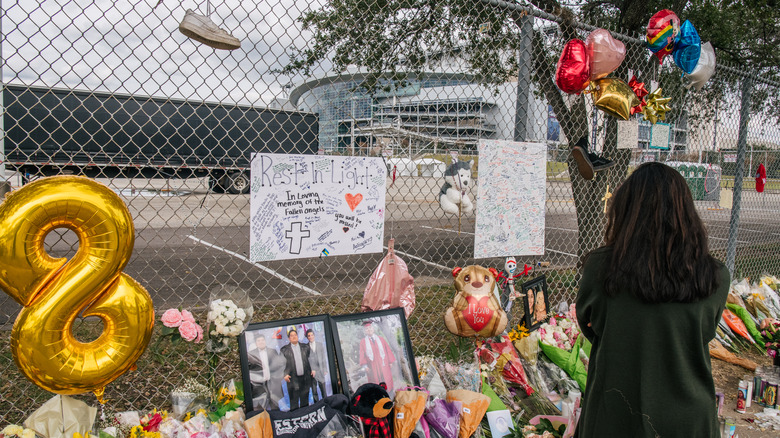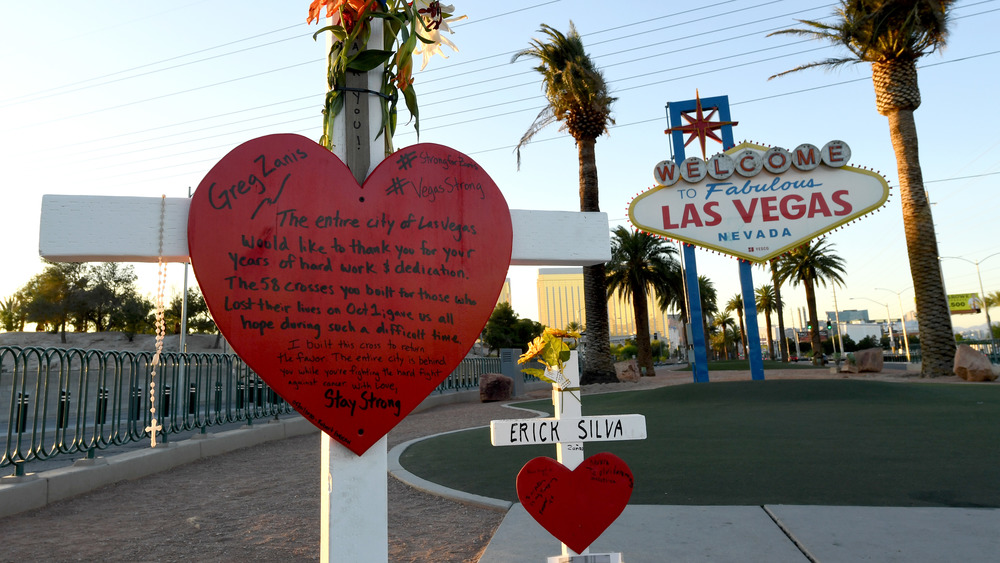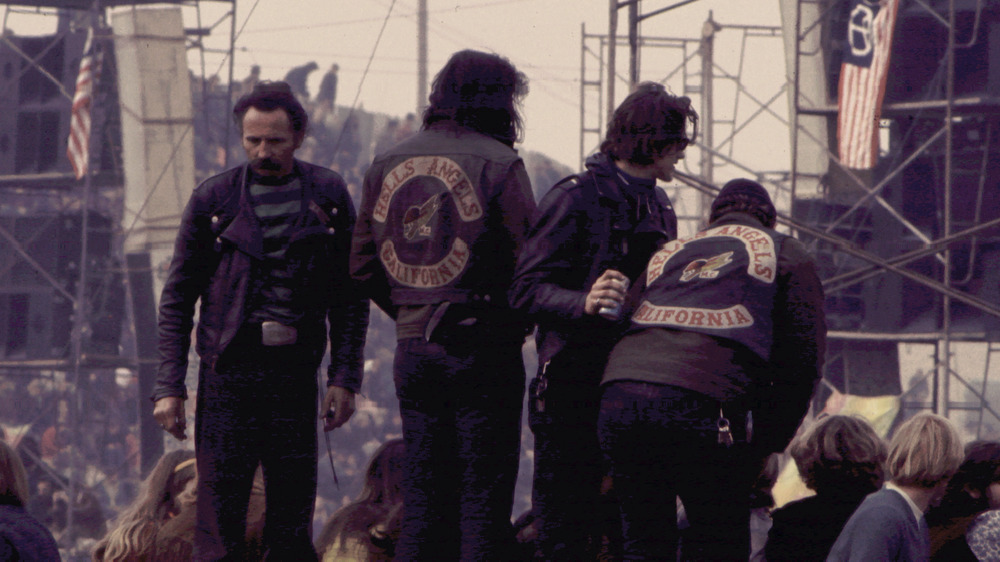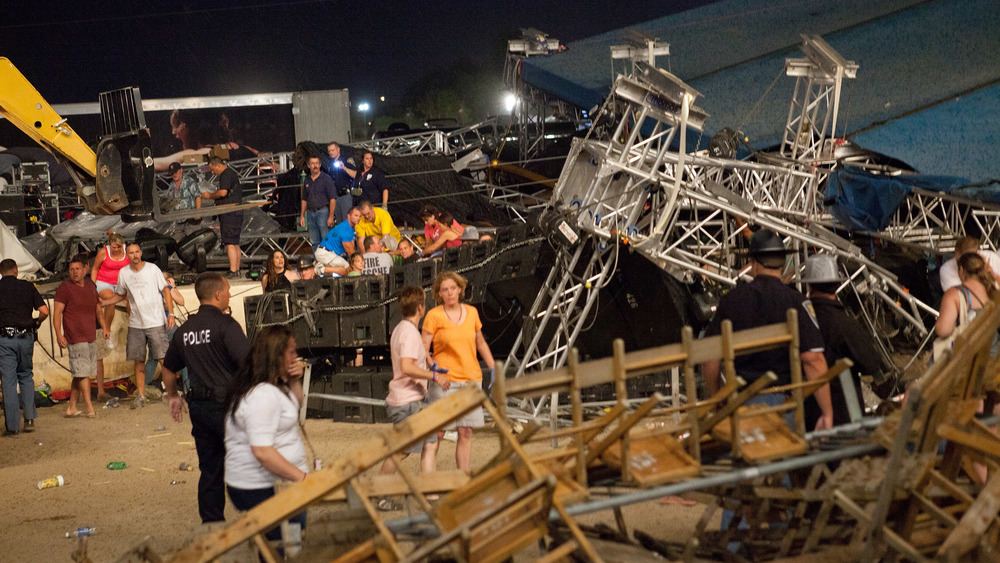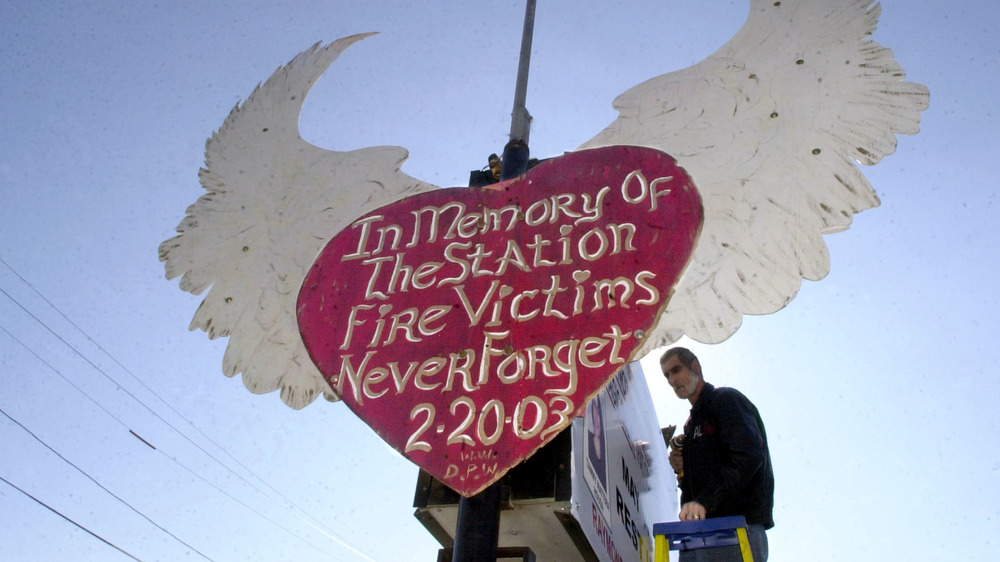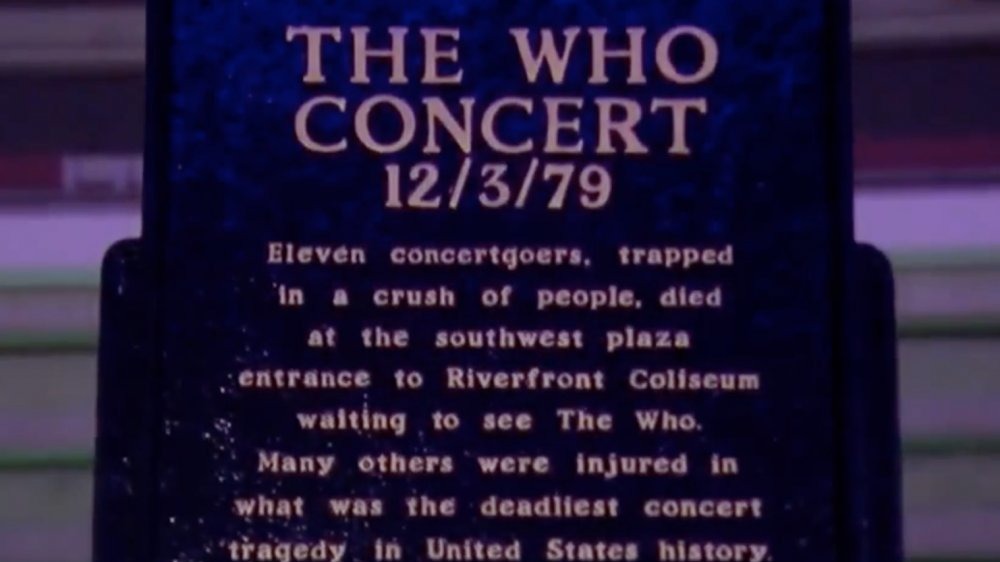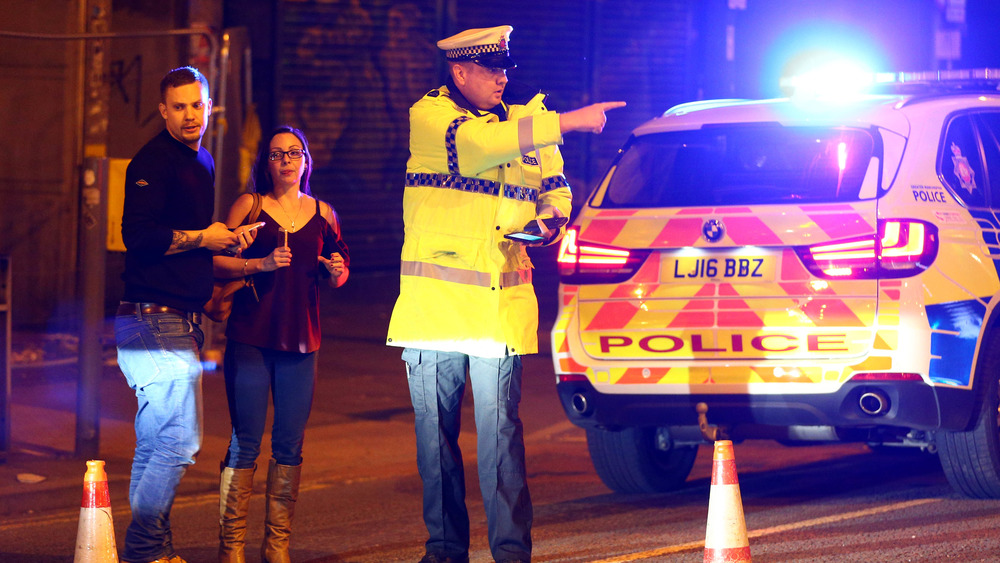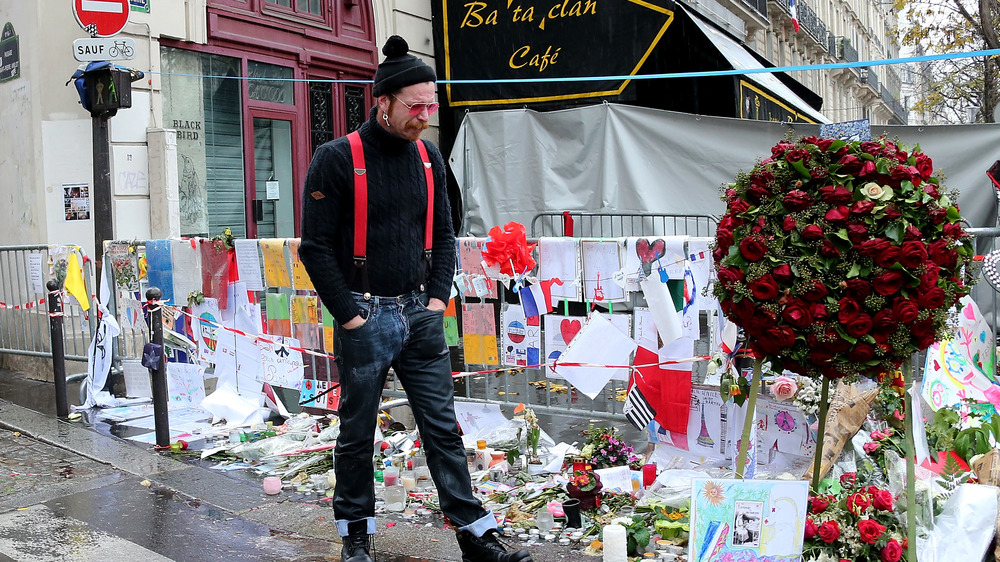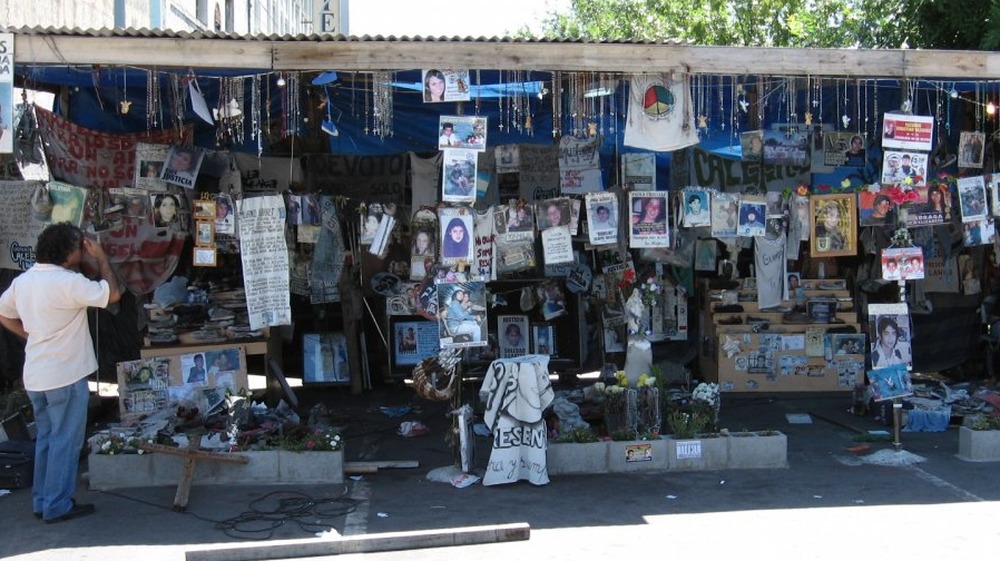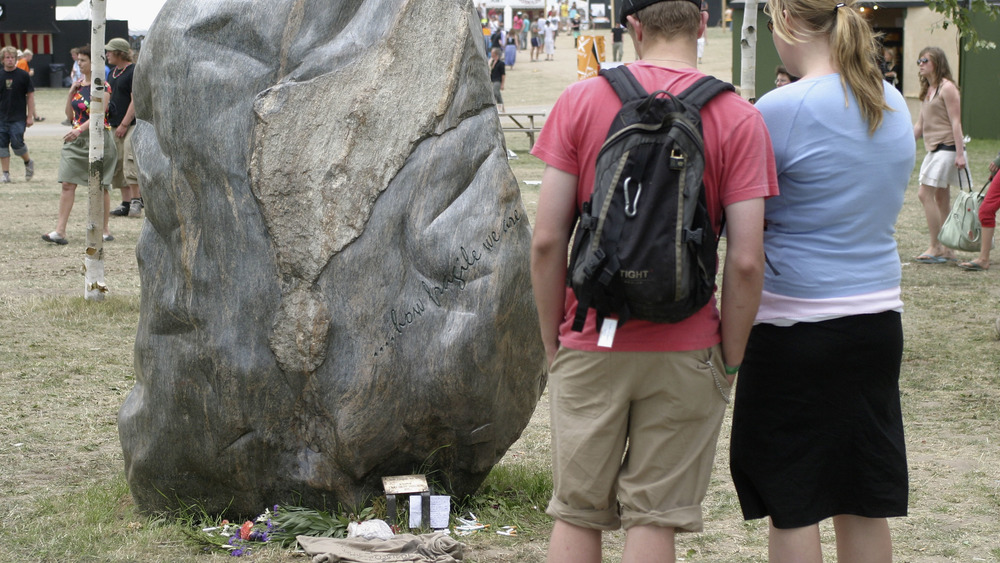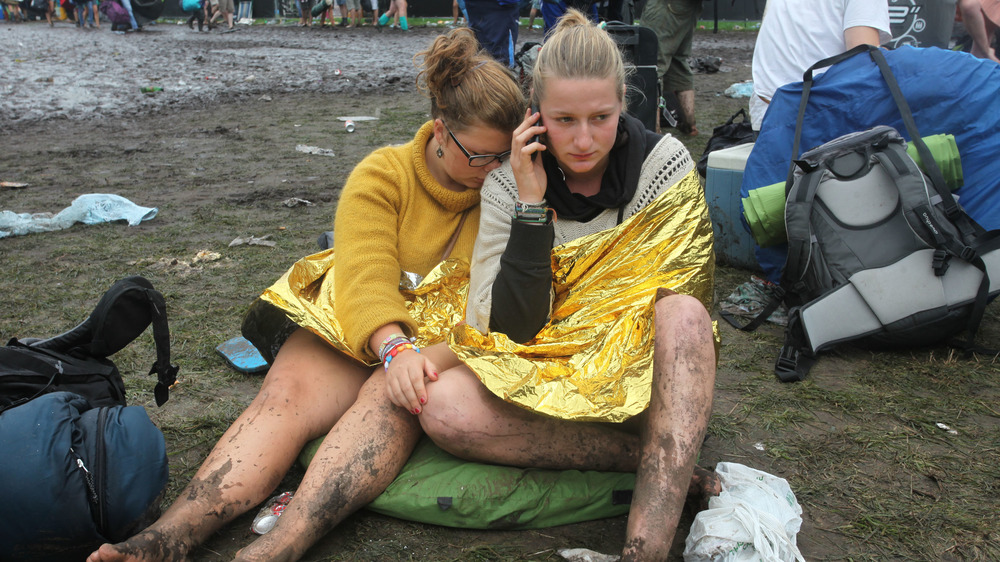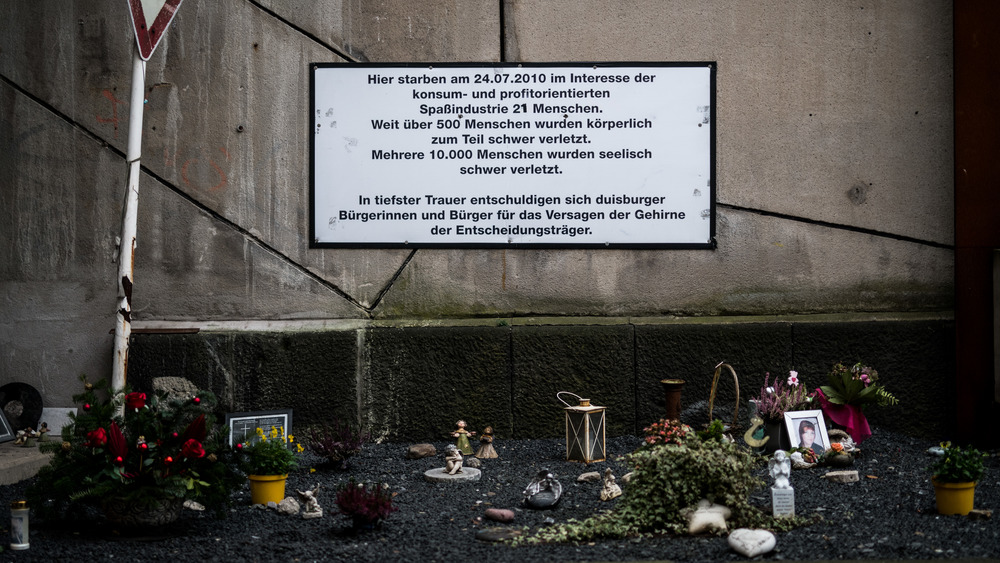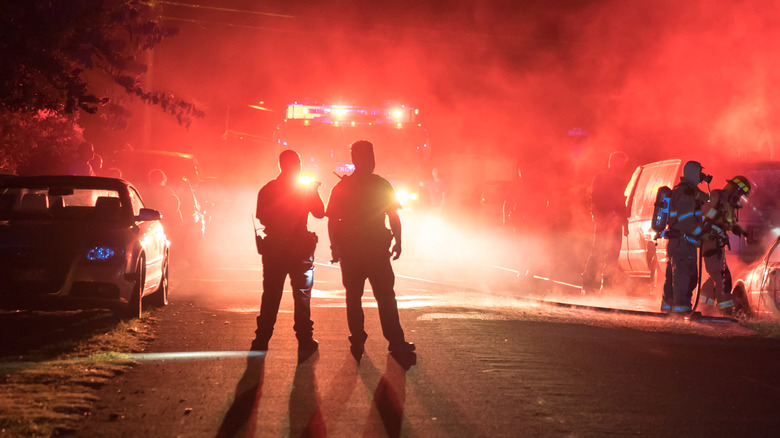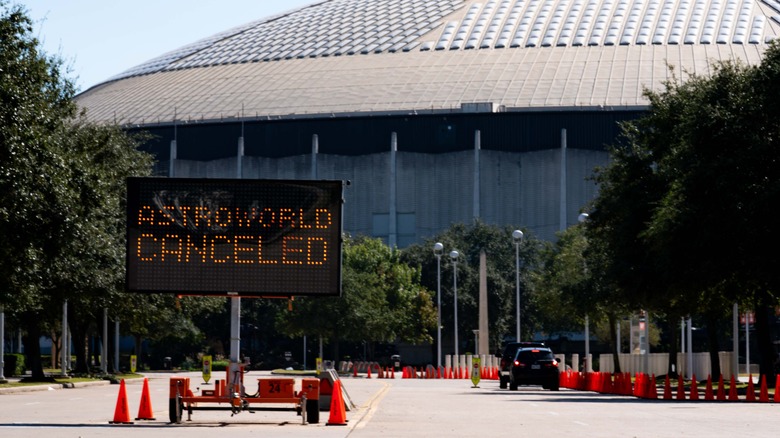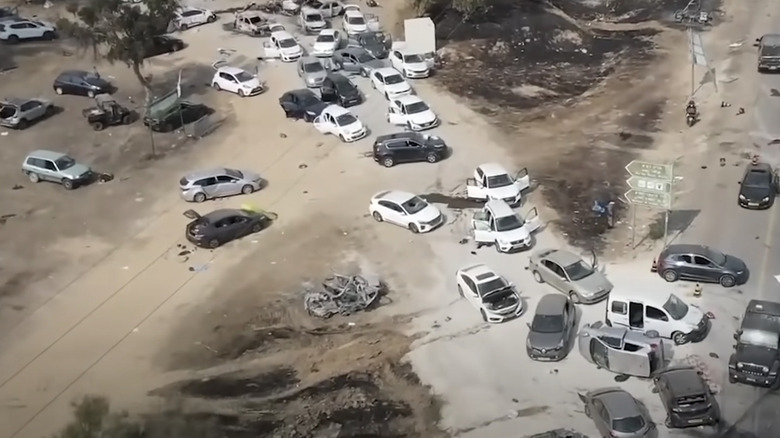Times Fans Died At Concerts
There aren't many things as exciting, or life-affirming and celebratory, as live music. Be it a rock show, pop diva performance, or outdoor festival with many different acts on the bill, a concert is the ideal way for many fans to experience the songs of their favorite singers and bands — it's a loud, visceral, and up close and personal happening, and as a bonus, it's one shared by hundreds or thousands of kindred souls.
A concert ought to be a fun night out, a few hours of escape from the worries and dangers of day-to-day-life, but occasionally, the entertainment fades and tragedy emerges. There's a lot that can go wrong at a show, be it faulty technical equipment, severe weather, poorly managed and large crowds, or a dangerous element that somehow gained admittance. The result: People can and do die at concerts. Here are some of the most tragic musical performances in history.
The Route 91 Festival ended in the deadliest shooting in American history
The evening of October 1, 2017, looked to be a great time for fans of Jason Aldean. The "Dirt Road Anthem" singer was a headlining act of the Route 91 Harvest, a three-day festival that included performances by other country superstars such as Blake Shelton and Miranda Lambert. And unlike other festivals staged in a rural or remote location, Route 91 went down right on the famous Las Vegas "Strip," just outside the Mandalay Bay resort. That's where a man named Stephen Paddock booked a suite, his hotel window providing clear views of the Aldean show. That was also the place from where he unleashed a sniper-style assault on concertgoers.
Paddock opened fire on the crowd, and hundreds of people suffered wounds and injuries. In all, 58 people lost their lives (not counting Paddock, who killed himself after firing on the concert), making this the deadliest mass shooting to ever take place on American soil. As noted by the Las Vegas Review-Journal, two more victims later died of complications from wounds sustained that night, bringing the death toll to 60. Hundreds of Jason Aldean fans had gathered to rock out to some tunes and just have a good time when Stephen Paddock opened fire from his hotel room. More than 500 people were injured.
Security guards killed a fan at Altamont
All-day outdoor music festivals originated in the late '60s with events like Woodstock and the Altamont Free Concert, held at a raceway near San Francisco in December 1969. According to Rolling Stone, organizer Mick Jagger (singer of the headlining Rolling Stones) hired members of the Hells Angels motorcycle gang to work security. According to Saul Austerlitz's book "Just a Shot Away" (via Rolling Stone), the Hells Angels antagonized the crowd all day, tearing through the crowd on their motorcycles and using pool cues to hit anybody who got too close to them. The crowd had just about had enough, among them 18-year-old attendee Meredith Hunter, who retrieved a handgun from his car, for self-protection from the security guards, before heading back into the show to see the Rolling Stones play.
The bikers roughly enforced a wide berth around the stage as the band played, but Hunter climbed up onto a speaker. A Hells Angel attempted to pull him off by his hair and then yanked him by the arm. Hunter resisted, and he got punched in the mouth. Before long, he was surrounded by five Hells Angels, who pulled him out of public view and savagely beat him, kicked him in the head, and repeatedly stabbed him until he was nearly dead. Well-meaning strangers managed to grab Hunter and escort him to safety, but medical personnel pronounced him dead in the Altamont parking lot.
The stage collapsed at a Sugarland show
Sugarland is a duo made up of singer Jennifer Nettles and multi-instrumentalist Kristian Bush, and they forged a career as one of the most successful country acts of the 2000s. Sugarland's first three albums each went triple-platinum and generated numerous country chart-topping crowd-pleasers like "Want To," "Settlin'," "All I Want to Do," and "It Happens."
As detailed by CMT, fans were certainly looking to hear those songs and more when they packed into the Indiana State Fair in August 2011 to see the duo play live at an open-air performance space. Nettles and Bush hadn't even played a note when things took a turn for the tragic. A storm whipped through the fair, including a monstrous gust of wind so powerful that it tore the roof off of the outdoor venue and knocked down a canopy and upended scaffolding and other equipment. All that material fell into the crowd with great speed and force, where it crushed and immediately killed four fans. (Three others, a crew member, and two attendees were also struck by debris and died within the week.)
A Great White nightclub show ended in tragedy
On February 20, 2003, The Station, a modest nightclub in West Warwick, Rhode Island, hosted a concert by the band Great White, best known for its 1989 hit "Once Bitten, Twice Shy." Great White was a hair metal band and, like its fellow '80s veterans, couldn't fill giant arenas the way it used to, but hardcore fans remained eager to see a show with all the trimmings, including pyrotechnics. Despite the smaller venue, Great White's tour manager began the show by setting off some dazzling explosions toward the back of the stage. The Station's owners later said they'd never approved Great White's pyro, and with good reason — those things can quickly start a fire, which is exactly what happened.
According to Rolling Stone, lead singer Jack Russell did what he could to stop the spreading flames by tossing cups of water, but the fire only grew. The band fled via a fire exit just off the stage, while more than 400 fans in attendance scrambled for the four posted exits. A bouncer wouldn't let anyone use the stage door, and two of the exits had been barricaded, leading to a crush of people at the open exits. A huge crowd remained trapped inside as the fire quickly destroyed the club, exploding liquor bottles, cracking beams, and causing the ceiling to collapse. It eventually engulfed the Great White fans in flames, too — a total of 100 people died because of the fire.
11 people were crushed to death at a Who concert
In 1979, The Who embarked on its first tour following the death of drummer Keith Moon. With Kenny Jones behind the kit, The Who was booked to play Cincinnati's large Riverfront Coliseum on December 3, 1979. The seating arrangement for the concert followed the standard for rock shows of the era: "festival style," according to Rolling Stone – general admission with no reserved seats. That left more than 14,000 Who fans to battle for a position as close to the stage as possible.
Ticket-holders started to line up for the evening show at about 1:30 PM, and by 6:30 PM, around 8,000 agitated fans had gathered and pushed up against the Coliseum's locked doors. They only got more antsy when they could hear The Who go through its soundcheck, and also as the temperature dropped to 36 degrees and the wind picked up. When finally allowed entry, the crowd became a stampede, and Who fans pushed, knocked down, and tramped each other to get through the two open doors. Fourteen other doors remained locked.
The concert went on as scheduled, but just before The Who was set to retake the stage for an encore, their manager told them to play that last bit quickly, informing the band that the pre-show stampede had turned fatal: 11 people were essentially crushed to death. Weeks later, the Cincinnati City Council passed a law that banned festival seating at concerts.
Terrorists carried out an attack on an Ariana Grande show
Pop sensation Ariana Grande took her R&B-flavored vocal acrobatics to the United Kingdom in May 2017, performing for thousands of fans at Manchester Arena. Immediately after the end of Grande's show, according to History, the atmosphere turned from adulation and appreciation to chaos. Witnesses reported hearing an explosion and seeing a flash of light. Debris and fire pursued the crowd in the aftermath of what had been the detonation of a bomb. Panicked fans ran for the exits, while others were knocked down by injuries sustained in the blast itself.
Per the BBC, police identified the assailant as Salman Abedi, a suicide bomber who died in his own attack. As families and groups separated by panic, fire, and shrapnel attempted to find each other and get to safety, more than 50 people were rushed to hospitals with life-threatening injuries, according to CNN. Tragically, 22 people died that night in Manchester.
Terrorists opened fire on an Eagles of Death Metal show in Paris
The evening of November 13, 2015, ranks among the most shockingly sad and horrifying nights in history, such was the level of unspeakable, unprovoked violence endured by the city of Paris. In a coordinated attack by ISIS, according to the BBC, victims in six locales around the city were besieged by bombers and gunmen. Shortly after 9:00 PM, a suicide bomber activated his weaponry outside the packed Sade de France, followed by heavily armed attackers opening fire on multiple crowded bars and restaurants.
The deadliest terrorist raid of the night, however, was unleashed on the Bataclan, a 1,500-seat concert venue, sold out for that evening's show by American hard rock band Eagles of Death Metal. Three attackers burst into the hall and fired assault rifles into the crowd. Around 100 people were taken to Paris hospitals to treat potentially critical injuries, while 89 people died immediately as a result of the gunfire.
A fire at a Callajeros concert in Argentina killed nearly 200
By the end of 2004, Callejeros was one of the biggest rock bands in the Spanish-speaking Americas. The Argentinian group had just released its album, "Rocanroles sin destino," and was so successful throughout Latin America that it could fill big Buenos Aires venues like the Estadio de Excursionistas and Obras Sanitarias Stadium. It was an exclusive and tantalizing event, then, when Callejeros booked a show at the modest República Cromagnon in Buenos Aires right around New Year's Eve.
Fireworks are a big part of New Year's festivities for a lot of people, and according to CBS News, several fans at the Callejeros show kept setting them off, despite the danger of doing so in an indoor venue and despite the band reportedly repeatedly asking them not to do that. But the pyro play continued, and at one point, a fan threw a flare into the air, which hit the ceiling, sending igniting chunks to fall to the ground below. The interior of the República Cromagnon was quickly set ablaze, and the 4,000 or so fans in attendance (nearly tripling the club's 1,500-person capacity) ran for the doors, only to find that many had been blocked to prevent non-paying fans from sneaking in. Not everyone could get out, so a lot of people perished in the horrific fire. All told, 194 people died because of the fire at the concert, for which the band was held legally liable.
A stampede at a Pearl Jam concert left eight dead
The Roskilde Festival, held just west of Copenhagen, Denmark, was launched in 1971, part of the first generation of big, multi-act outdoor rock events in the wake of Woodstock. It's been an annual occurrence through to the modern day, ranking with the likes of Coachella and Bumbershoot as one of the premier outdoor festivals and attracting around 80,000 people each year.
The 2000 Roskilde Festival is undoubtedly the worst staging in the institution's history. The massively popular Pearl Jam played late at night on the festival's first evening. According to the BBC, the grounds were muddy following a day of rain, and hundreds of fans had trouble staying upright. That same crowd also continuously pushed and shoved to get closer to the stage, putting tremendous pressure on the people nearest to the band. The force, combined with the mud, led many to slip and fall, and as the crowd lunged forward, they were crushed and trampled. Pearl Jam, who had asked fans to ease up on the pushing, stopped playing, and witnesses reported hearing anguished screams of victims and other concertgoers. As a result of the rush, 26 people were hospitalized, three were seriously injured, and eight died.
A deadly storm hit the 2011 Pukkelpop Festival
Pukkelpop started out as a small showcase for bands in and around the community of Leopoldsburg, Belgium, in 1985, but by the 21st century, it had evolved into a massive, outdoor, three-day rock and pop festival attended by tens of thousands each year, one of the biggest events of its kind in Europe. According to the BBC, around 60,000 fans headed to the 2011 iteration of Pukkelpop, headlined by major acts like the Foo Fighters and Eminem. Those musicians would never actually take the stage, on account of how the event was canceled after a sudden, unexpected, and completely devastating storm on the opening night of the festival destroyed the grounds and ended multiple lives.
Extremely high winds and a torrential downpour struck with such velocity that the stage collapsed, screens fell down, tents tore up, and trees in the area were ripped out of the ground. All that unsecured material — which organizers say was checked for safety prior to the festival, in the event of a freak storm such as the one that hit — was left to catch in the wind and fly around. More than 140 people were injured in the chaos, and five people died.
More than 20 people died at the Love Parade festival
It billed itself as a music festival, but Love Parade was more of a multi-day, nonstop party, or a rave in which hundreds of thousands of electronic music fans would descend on various German cities each summer and dance for hours to DJ sets. The 2010 Love Parade in Duisburg was absolutely massive, with police estimating attendance of 1.4 million people, according to Sky News. And that was a recipe for disaster.
The main grounds of the festival could be accessed by just one narrow tunnel, and on July 24, 2010, hundreds of thousands of revelers all tried to squeeze through it at virtually the same time. That resulted in a crush of too many bodies in too small a space. Per the BBC, more than 500 people were injured in the melee. Sadly, an additional 21 people were trampled or crushed to death. Ten organizers and officials were later held criminally at fault for those deaths, while all future Love Parades were canceled soon after.
A fire at a Creation concert killed fans and a member of the band
Gulliver's occupied a large piece of real estate in a shopping center in suburban Port Chester, New York, comprising a restaurant, bar, and a nightclub. A local band called Creation took the stage at about midnight on June 30, 1974, according to The New York Times, and played for about an hour before singer George Chase announced that the show was over because of a fire in the bowling alley next door. The crowd filed out relatively calmly, heading through a small staircase that led to a dining room and then outside doors. As they did, huge plumes of toxic smoke burst into the stairwell and the dance floor, shrouding the room in darkness and leading to panic as hundreds gasped for air. Much of the crowd couldn't even get out, as the stairwell was blocked by the bodies of people instantly knocked down and out by the smoke.
Police later arrested a man for purposely setting the fire to cover his tracks after he robbed the bowling alley's cigarette machines. He was charged with reckless manslaughter, as he never intended to kill anyone. And yet the loss of life was significant: 24 people (including Creation's keyboard player) died of smoke inhalation, although their bodies were so heavily burned that they had to be identified by dental records.
Travis Scott's Astroworld became a mass casualty event
On November 5, 2021, Travis Scott took the stage at his Astroworld festival in Houston, Texas. By the time his set was over, eight people would be dead, including two children, and hundreds more injured, according to ABC News 13. Two more died several days later of injuries related to the event.
Video and eyewitnesses have shed some light on what happened. The already unruly and large crowd — which police and security had been worried about being able to control for weeks — surged forward, trying to get closer to the stage, until people were squeezed in so tight, some of them couldn't breathe. Billy Nasser told ABC News 7 that he was "picking people up and trying to drag them out," but his efforts were too late for one poor fan. "I picked him up. People were stepping on him. People were like stomping, and I picked his head up and I looked at his eyes, and his eyes were just white, rolled back to the back of his head," Nasser said.
In the aftermath, people pointed blame at Travis Scott and the concert promoter Live Nation. Vulture reports that the lawyer representing one injured concertgoer who filed a lawsuit said, "There is every indication that the performers, organizers, and venue were not only aware of the hectic crowd but also that injuries and potential deaths may have occurred. Still, they decided to put profits over their attendees and allowed the deadly show to go on." However, no one was indicted.
About 260 people were killed at an Israeli outdoor music festival
On Saturday, October 7, 2023, the terrorist group Hamas launched what appeared to be a surprise attack on Israel. Utilizing both land and air, Hamas worked out of Gaza, the Palestinian-controlled territory to the west of Israel. Israeli Prime Minister Benjamin Netanyahu declared war against Palestine following the reported deaths of 700 mostly civilian Israelis, with a large portion of the losses stemming from an assault on the Tribe of Nova, according to the AP, a weekend electronic music festival being held in an open field outside Kibbutz Re'im in southern Israel.
As the headlining DJ took the stage at around 6 a.m., the music was undercut by air raid sirens warning of the incoming bombardment of aerial missiles. Meanwhile, Hamas troops who had broken their way through separation and security barriers infiltrated the crowd and began opening fire. As attendees scrambled for safety, Hamas militants stationed themselves at the entrance to bomb shelters, gunning down anyone who tried to gain entry. In addition to the injuries and deaths, Hamas also kidnapped festival-goers and took them hostage. Within 48 hours after the attack, Israeli rescue organization Zaka said that it had recovered 260 bodies, with that number expected to rise as aid workers search the rubble. The Tribe of Nova tragedy represents the worst civilian massacre in Israeli history.
